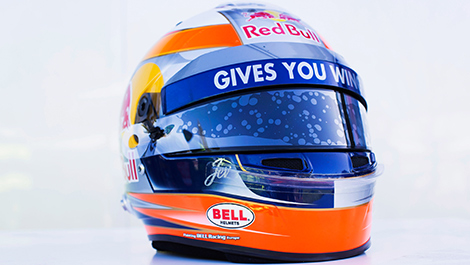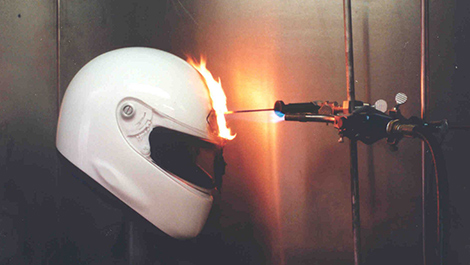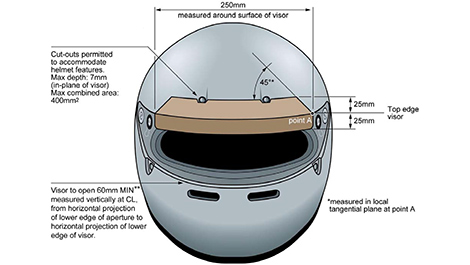Oct
16th
Stay connected Subscribe to our RSS feed
Jules Bianchi's terrible and unexpected crash at Suzuka during the Japanese Grand Prix sadly reminded us that the helmets are not just cool items, but primarily a vital piece of safety equipment.
The full-face crash helmet is the only thing that saves the head of the driver in case of an accident, and protects it from flying debris, forceful decelerations, and impacts.
Auto123.com talked about helmet safety with Martine Kindt Cohen, C.E.O. of Bell Racing Europe.
The sporting regulations state that F1 drivers must wear a Snell SA2015 crash helmet homologated to the FIA Standard 8860 - Advanced
Helmet Test Specification (Technical List N°33).
A manufacturer that wants to have its crash helmets certified must send a certain number of them to an approved test lab.
“The tests are performed by an approved laboratory. Then, a report is sent to the FIA which in return publish a list of the homologated crash helmets,” Mrs. Cohen explained.
The testing procedures are detailed in a document belonging to the FIA.
Tests conducted on the helmets include linear impact tests, abrasion tests, destructive tests, fireproof tests, and dynamic impacts tests. For all these tests, the conditions are clearly listed (such as forces to be applied, direction, temperature, speed of impact, height, etc.)
To guarantee a certain level of safety, the F1 helmet must be lower than a specified weight.
“The complete helmet must not be below 1,450g, including the radio system, drinking tube, spoilers, shield, and paint job. Good painters will not use more than 30g of paint to do a helmet,” she added.
Since Felipe Massa's accident in Hungary 2009, all F1 helmets must be fitted with a reinforcement panel.
“The reinforcement panel is a solution, but not a standard yet. The FIA included it in the sporting regulations, but it is not yet standard,” she said.
“This panel is made of Zylon and cost some 350 euros to make. The FIA gives the helmet manufacturer some freedom for the shape of the panel and its bounding method. Securing the panel in place is the most difficult procedure. We at Bell Sport Europe have found a very efficient way to put it in place. Our rivals have a few problems with that, especially in the rain. We would prefer that this panel be integrated into the shell of the helmet. That would be much better,” Mrs. Cohen explained.
The full-face crash helmet is the only thing that saves the head of the driver in case of an accident, and protects it from flying debris, forceful decelerations, and impacts.
 |
| Toro Rosso Jean-Eric Vergne's crash helmet. The reinforcement panel is seen above the sheild. (Photo: WRi2) |
Auto123.com talked about helmet safety with Martine Kindt Cohen, C.E.O. of Bell Racing Europe.
The sporting regulations state that F1 drivers must wear a Snell SA2015 crash helmet homologated to the FIA Standard 8860 - Advanced
Helmet Test Specification (Technical List N°33).
A manufacturer that wants to have its crash helmets certified must send a certain number of them to an approved test lab.
“The tests are performed by an approved laboratory. Then, a report is sent to the FIA which in return publish a list of the homologated crash helmets,” Mrs. Cohen explained.
The testing procedures are detailed in a document belonging to the FIA.
Tests conducted on the helmets include linear impact tests, abrasion tests, destructive tests, fireproof tests, and dynamic impacts tests. For all these tests, the conditions are clearly listed (such as forces to be applied, direction, temperature, speed of impact, height, etc.)
To guarantee a certain level of safety, the F1 helmet must be lower than a specified weight.
 |
| Test of resistance to fire. (Photo: Snell Memorial Foundation) |
“The complete helmet must not be below 1,450g, including the radio system, drinking tube, spoilers, shield, and paint job. Good painters will not use more than 30g of paint to do a helmet,” she added.
Since Felipe Massa's accident in Hungary 2009, all F1 helmets must be fitted with a reinforcement panel.
 |
| FIA's technical requirements for the reinforcement panel. (Image: FIA) |
“The reinforcement panel is a solution, but not a standard yet. The FIA included it in the sporting regulations, but it is not yet standard,” she said.
“This panel is made of Zylon and cost some 350 euros to make. The FIA gives the helmet manufacturer some freedom for the shape of the panel and its bounding method. Securing the panel in place is the most difficult procedure. We at Bell Sport Europe have found a very efficient way to put it in place. Our rivals have a few problems with that, especially in the rain. We would prefer that this panel be integrated into the shell of the helmet. That would be much better,” Mrs. Cohen explained.
 The latest auto news, reviews, prices, product and vehicle releases.
The latest auto news, reviews, prices, product and vehicle releases.